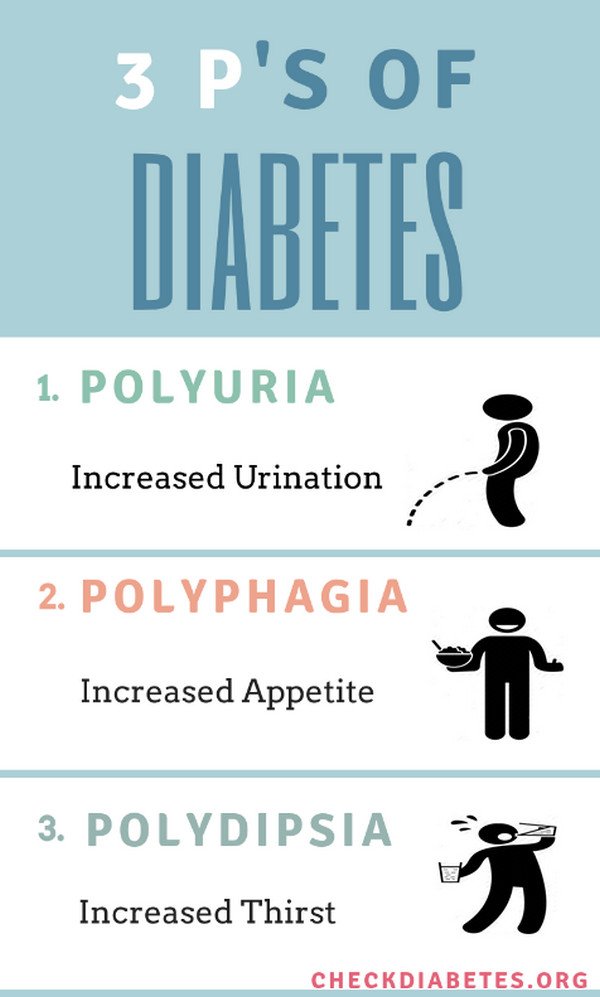Diabetes is a medical condition affecting people all across the globe. If you have diabetes, you will have it for your entire life. There is no cure for diabetes. Fortunately, it can be managed. All you need to do is to make sure that the blood sugar level is within the normal range.
A significant part of diabetes management is being aware of the signs and symptoms. There are various symptoms associated with diabetes, but there are three cardinal signs you should watch out for. They are called the 3 Ps of diabetes.
They are polyuria, polydipsia, and polyphagia.
These symptoms can develop quickly, especially in patients with type 1 diabetes mellitus. ( see : difference between type 1 and type 2 diabetes)

(The image shows the 3Ps of diabetes.)
We are going to discuss in detail the 3Ps of diabetes in this article.
#1 – Polyuria

(Diabetes is one of the causes for frequently urinating.)
Polyuria is the medical term for a feeling of having to urinate frequently. It is caused by a high content of sugar in the urine. Too much water in the body is lost through urination.
A patient will experience many sleepless nights because of frequent urination. What is more alarming is that not only the urgency to urinate is increased but as well as the amount of urine.
What is the cause of polyuria?
If the level of sugar in the blood is more than the normal range, the body will have to get rid of the excess sugar. The kidneys will filter the excess sugar in the blood through urination leading to an increase in frequency and amount of urine. (1, 2, 3, and 4)
#2 – Polydipsia
In the medical language, polydipsia means increased thirst and fluid intake. As the patient urinates more than the usual, the body feels weak and goes into a dehydration mode. This results in increased thirst and so the patient feels the need to drink more and more fluid.
What is the cause of polydipsia?
An increase in thirst is caused by the excessive loss of water in the body secondary to frequent urination. To quench thirst, a diabetic patient drinks a lot of water.
However, the result is only temporary as the water being drunk will then be excreted in the urine. If you feel thirsty most of the time and at the same time urinate too often, then you need to start suspecting diabetes, especially if diabetes runs in your family. (3, 4, 5, and 6)
#3 – Polyphagia
It is the increased in appetite caused by the lack of production of insulin in the body. A person with diabetes poorly absorbs blood sugar in the tissue leading to a decreased in energy production and increased in appetite.
What’s sets diabetic patient’s hunger apart from the rest is that a person with diabetes tends to always feel hungry even after just finishing a full meal.
What is the cause of polyphagia?
A normal healthy individual consumes food and converts it to glucose before the body can use it as energy. For the body to use glucose as an energy source, it needs the help of the hormone insulin.
In the case of a person with diabetes, the pancreas is not producing enough insulin to facilitate allow the passage of glucose to the cells. The cells of the body are continuously starved for glucose.
The body sends a signal to the brain to eat more to supplement the body’s need for glucose. It is the reason why a person with diabetes is always hungry even after consuming a full meal. (6, 7, 8, and 9)
What to keep in mind?
If you experience the 3Ps mentioned above, you need to seek medical attention, especially if you have a family history of diabetes.
Diabetes is something that should not be taken lightly as failure to manage the condition can be life-threatening. It could lead to diabetic ketoacidosis and hyperosmolar hyperglycemic state which could eventually lead to coma or death. (2, 8, and 10)
References:
- https://www.diabetes.co.uk/The-big-three-diabetes-signs-and-symptoms.html
- https://www.livestrong.com/article/87846-ps-diabetes/
- https://www.epainassist.com/diabetes/3-ps-of-diabetes
- https://diamell.wordpress.com/2012/03/03/3-ps-of-diabetes/
- https://www.news-medical.net/health/Diabetes-Pathophysiology.aspx
- https://www.medicinenet.com/diabetes_symptoms_in_men/article.htm
- https://www.webmd.com/diabetes/guide/understanding-diabetes-symptoms
- https://www.healthline.com/health/diabetes/symptoms-in-women
- https://www.mayoclinic.org/diseases-conditions/diabetes/symptoms-causes/syc-20371444
- https://www.rd.com/health/conditions/signs-diabetes/


